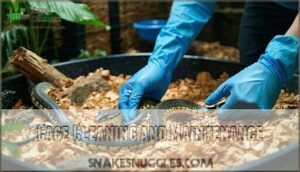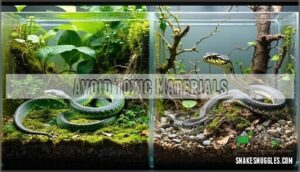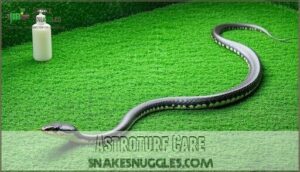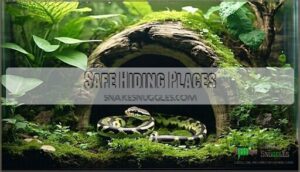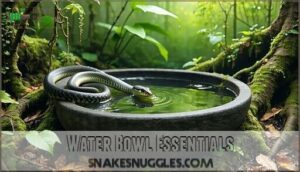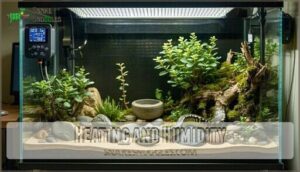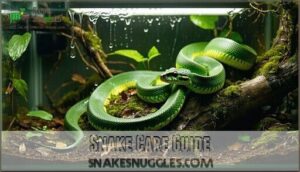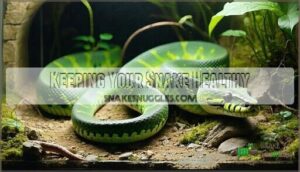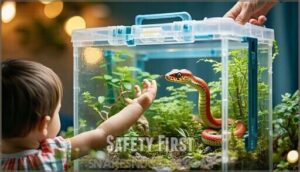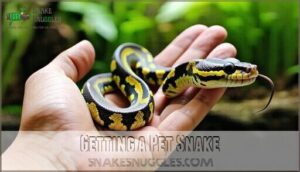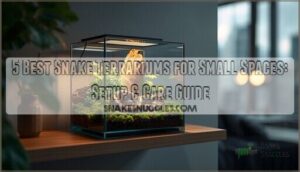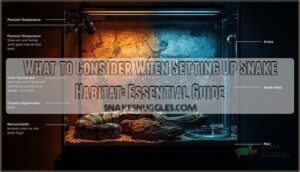This site is supported by our readers. We may earn a commission, at no cost to you, if you purchase through links.
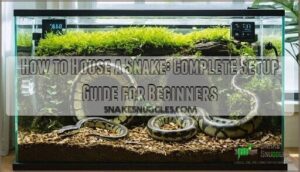 Housing a snake requires selecting an enclosure that’s longer and deeper than tall, providing adequate space for your snake to stretch fully.
Housing a snake requires selecting an enclosure that’s longer and deeper than tall, providing adequate space for your snake to stretch fully.
Choose glass terrariums or PVC enclosures with secure, escape-proof lids since snakes are notorious escape artists.
Maintain proper temperature gradients using under-tank heaters, with basking spots around 85-90°F and cool areas at 75-80°F.
Include hiding spots on both warm and cool sides, a water bowl large enough for soaking, and appropriate substrate like cypress mulch or paper towels.
Monitor humidity levels between 50-60% for most species.
The key to successfully learning how to house a snake lies in understanding your specific species’ needs, from ball pythons requiring higher humidity to corn snakes preferring drier conditions, which is crucial for creating an ideal environment with the right temperature gradients.
Table Of Contents
- Key Takeaways
- Snake Housing Essentials
- Cage Cleaning and Maintenance
- Substrate and Bedding
- Cage Enrichment and Accessories
- Heating and Humidity
- Snake Care Guide
- Keeping Your Snake Healthy
- Safety First
- Getting a Pet Snake
- Frequently Asked Questions (FAQs)
- What is an African house snake?
- How to search for a snake in the house?
- How do I get rid of a snake in my house?
- What happened to the snake house in Rexburg Idaho?
- What housing does a snake need?
- How to care for a snake for beginners?
- What is the best setup for a snake?
- How to scare a snake out of the house?
- What type of housing does a snake need?
- How to take care of a snake for beginners?
- Conclusion
Key Takeaways
- You’ll need a secure enclosure that’s at least as long as your snake’s body length – choose glass terrariums or PVC enclosures with escape-proof lids since snakes are notorious escape artists.
- Create proper temperature gradients using under-tank heaters – maintain basking spots around 85-90°F and cool areas at 75-80°F with reliable thermostats to prevent overheating.
- Provide hiding spots on both warm and cool sides of the enclosure – include a water bowl large enough for soaking and choose safe substrates like cypress mulch or paper towels.
- Monitor humidity levels between 50-60% for most species – research your specific snake’s needs since ball pythons require higher humidity while corn snakes prefer drier conditions.
Snake Housing Essentials
Creating the perfect snake home starts with understanding your species’ specific needs for space, security, and comfort.
You’ll need proper cage dimensions, escape-proof materials, and the right setup to keep your serpent friend healthy and stress-free.
Cage Size and Setup
Getting your snake’s cage size right is essential for their health and happiness. Most snake owners underestimate space requirements, leading to stressed reptiles.
Proper cage sizing prevents stressed, unhealthy snakes from developing behavioral problems.
Your enclosure design must meet basic space requirements. The cage should be at least as long as your snake’s body length. Ball pythons need 30-40 gallons minimum, while corn snakes require enclosures with width one-third their length. Start juveniles in 20-gallon tanks, then upgrade as they grow.
Essential cage layout considerations:
- Length equals freedom – Your snake needs full stretching space
- Width prevents claustrophobia – Adequate turning room reduces stress
- Height allows natural behaviors – Some species enjoy climbing
- Ventilation systems prevent respiratory issues – Fresh air circulation is paramount
Escapeproof enclosures require secure locking mechanisms and sealed seams. PVC enclosures excel at humidity retention and easy cleaning. Avoid glass terrariums with screen tops – they’re heavy and poorly maintain temperature gradients.
Your snake tank setup should prioritize their natural habitat creation needs over aesthetics. Providing a snake welfare environment is essential for the well-being of your pet snake.
Material Matters
Several materials work well for snake enclosures, each with trade-offs.
Plexiglass and glass offer excellent visibility and easy cleaning. Plywood types like melamine-coated boards provide water resistance for humid setups.
Seal wooden vivarium edges with aquarium-safe sealant options. Wood finishes like polyurethane protect bare surfaces. Avoid cedar – its phenols harm reptiles.
Choose eco materials that prioritize your snake’s health over convenience. When designing an enclosure, consider using Plexiglass enclosures for ideal visibility and durability.
Escape-Proof Enclosures
Secure snake enclosures need proper sealing and locking mechanisms to prevent escapes.
Check these escape prevention features:
- Secure lids with heavy-duty latches that snakes can’t push open
- Sealed seams using aquarium-safe silicone to eliminate gaps
- Ventilation systems with mesh screens too small for snake passage
- Locking mechanisms on doors and access points for added security
The features listed are crucial for maintaining a secure environment for snakes.
Cage Cleaning and Maintenance
You’ll need to clean your snake’s enclosure every two weeks to prevent disease and maintain proper hygiene.
Regular maintenance keeps your pet healthy and creates a comfortable living environment that supports natural behaviors, which is essential for maintaining proper hygiene.
Regular Clean-Up
Between routine maintenance and deep cleaning, daily spot-cleaning keeps your snake’s home fresh and healthy.
Remove waste immediately to prevent bacterial growth and maintain proper hygiene standards.
Essential Daily Tasks:
- Waste Removal – Remove feces and urates within 24 hours of discovery
- Cleaning Schedules – Check enclosure daily for messes requiring attention
- Disinfecting – Spot-treat soiled areas with reptile-safe cleaners immediately
- Odor Control – Address waste buildup before smells develop and spread
Consistent snake cage cleaning prevents disease transmission.
Your snake enclosure cleaning routine should focus on quick daily maintenance rather than waiting for weekly deep cleans.
Regular cleanup protects your pet’s health while keeping maintenance manageable.
Weekly Wash
Weekly snake cage cleaning transforms maintenance into a simple routine.
Remove your snake to a secure container, then wash the enclosure with hot water and mild soap solution. Rinse thoroughly and dry completely before returning your pet.
| Cleaning Step | Frequency | Purpose |
|---|---|---|
| Water Change | Weekly | Prevents bacterial growth and maintains snake hygiene |
| Substrate Replacement | Weekly | Controls humidity and eliminates waste buildup |
| Enclosure Cleaning | Weekly | Maintains proper snake cage maintenance and health |
This weekly wash prevents disease while maintaining ideal humidity control in your snake’s habitat.
Vivariums/Terrariums
Bioactive vivariums and planted terrariums offer stunning snake enclosures that mimic natural habitats.
These setups require dedicated maintenance routines. You’ll manage substrate moisture, prune terrarium plants, and monitor reptile lighting systems.
Vivarium design demands careful habitat creation balancing aesthetics with your snake’s needs. High-maintenance systems need consistent care for essential vivarium setup success.
Regular snake cage cleaning is vital to prevent bacterial growth and maintain a healthy environment.
Substrate and Bedding
You’ll need the right substrate to keep your snake comfortable and your enclosure clean. Choose materials that are safe, easy to maintain, and support your snake’s natural behaviors.
Easy Clean Options
When choosing substrate options for your snake’s home, prioritize materials that make cleaning a snap.
These enclosure liners transform waste management from a chore into a quick task.
- Newspaper: Cheap, absorbent, and perfect for daily spot cleaning
- Butcher paper: Clean white surface that shows waste clearly
- Reptile carpet: Washable option providing excellent traction for movement
- Paper towels: Ideal for sanitizing methods and immediate cleanup needs
These snake cage cleaning and maintenance solutions keep your pet healthy while saving you time and effort.
Avoid Toxic Materials
Your snake’s life depends on avoiding toxic materials. Cedar shavings release harmful oils that poison reptiles.
Sand, gravel, wood chips, corncob, walnut shells, and cat litter cause intestinal blockages and contamination. Choose reptile-safe products only.
Non-toxic substrates protect your snake from dangerous ingestion and respiratory issues. Additionally, be aware of toxic plants like toxic house plants to guarantee a safe environment.
Astroturf Care
Astroturf offers hassle-free substrate and bedding for your snake.
Clean your fake grass weekly with reptile-safe disinfectant. Remove waste immediately to prevent odors.
Turf sanitizing involves scrubbing, rinsing, and air-drying completely. Replace astroturf every few months when fibers wear down.
This turf maintenance keeps your snake healthy and comfortable.
Cage Enrichment and Accessories
Creating an enriched environment transforms your snake’s basic enclosure into a thriving habitat that promotes natural behaviors.
You’ll need to include specific accessories like branches for climbing species, secure hiding spots, stable rock formations, and properly sized water bowls to guarantee your snake feels secure and comfortable, which is crucial for creating an environment that supports complete concepts of snake care.
Natural Branches
Adding natural branches transforms your snake’s space into a climbing paradise. Your pet gets exercise, mental stimulation, and cozy hiding spots. Choose spider wood or cork bark for their mold-resistant properties and natural bark texture.
Branch Selection essentials:
- Size matters – Pick branches your snake can safely navigate without strain
- Wood decor safety – Avoid cedar or treated lumber that releases harmful chemicals
- Forest replication – Use tree roots and varied textures for authentic habitat feel
- Secure mounting – Anchor climbing branches firmly to prevent dangerous falls
- Regular inspection – Check for wear, pests, or damage that could harm your snake
Clean branches thoroughly before installation. Remove loose bark and debris. Position them to create natural snake hiding spots while maintaining clear sight lines for monitoring. Your snake will appreciate having multiple levels to explore, turning feeding time into an adventure through their miniature forest ecosystem.
Rock Solid Structures
Beyond basic basking spots, rocks create secure climbing branches and snake hiding spots within your enclosure design.
Choose heavy, stable stones that won’t shift during exploration. Secure them with aquarium-safe sealant or structural support brackets.
Natural granite or slate work best for rock solid structures. Skip heated rocks—they’re fire hazards that cause burns.
Safe Hiding Places
Your snake needs a secure retreat to feel safe and reduce stress.
Choose from these Hide Boxes and Snake Hides options:
- Rock Caves – Natural stone formations or artificial rock hideouts
- Plant Covers – Dense artificial vegetation for visual barriers
- Log Hides – Hollow wood pieces mimicking fallen trees
- Commercial hide boxes – Purpose-built snake safe hiding places
Size the hiding spots properly – your snake should fit snugly inside without being cramped.
Avoid sharp edges or toxic materials that could harm your pet.
Water Bowl Essentials
Your snake’s water bowl serves multiple functions beyond basic hydration.
Choose a heavy ceramic or stainless steel bowl that prevents tipping and allows your snake to soak comfortably.
- Water size: Select a bowl large enough for your snake to curl up inside completely
- Placement strategy: Position away from heat sources to prevent rapid evaporation and bacterial growth
- Material safety: Use non-porous materials like ceramic or stainless steel for easy sanitization
- Cleaning frequency: Replace water every 3-4 days or immediately when contaminated with waste
The water bowl also helps maintain proper humidity control in your snake’s habitat, making it one of the most important snake accessories for overall snake care.
Many options are available if you need a snake bowl.
Heating and Humidity
You’ll need proper heating and humidity control since snakes are ectothermic animals that rely on external heat sources to regulate their body temperature.
Temperature gradients and humidity monitoring systems create the ideal environment for your snake’s health and natural behaviors.
Ectotherms and Heat Sources
Since snakes are ectothermic creatures, they can’t generate their own body heat like you do. These cold-blooded animals depend entirely on external heating elements to maintain proper body temperature.
You’ll need to provide reliable heat sources to keep your snake healthy and active.
| Heat Source Type | Best For | Key Benefit |
|---|---|---|
| Basking spots | Diurnal species | Deep-penetrating warmth |
| Radiant panels | Large enclosures | Even heat distribution |
| Ceramic emitters | Nocturnal snakes | Light-free ambient heat |
Temperature control requires thermostat safety measures. Never run heating elements without proper regulation – uncontrolled heat sources can reach dangerous temperatures.
Heat Gradient and Temperature Monitoring
Temperature gradient systems require careful planning to keep your snake healthy.
You’ll need to monitor both warm and cool zones using reliable equipment.
- Basking Spot Setup – Position your heat mat under one-third of the enclosure to create a warm zone
- Thermostat Placement – Install temperature probes at both ends to track the gradient accurately
- Monitoring Temperature – Use infrared thermometers for spot checks and ceramic heater backup when needed
Heat pad safety depends on proper temperature regulation through quality thermostats.
This prevents overheating that could harm your snake.
Ideal Temperatures for Snakes
Your snake needs precise temperature control to stay healthy.
Create a heat gradient with a basking spot at 88-95°F and a cool zone at 75-80°F.
Thermostat placement prevents overheating.
Different species needs vary – ball pythons prefer warmer temperatures than corn snakes.
Consider seasonal changes for ideal care.
| Species | Basking Spot | Cool Zone |
|---|---|---|
| Ball Python | 88-92°F | 78-80°F |
| Corn Snake | 85-88°F | 75-78°F |
| King Snake | 85-90°F | 75-80°F |
Snake Care Guide
You’ll discover that snakes make surprisingly low-maintenance pets when you understand their basic needs.
Creating the right environment involves balancing temperature, humidity, and space to keep your scaly companion healthy and stress-free.
Fascinating Snake Facts
Understanding snake anatomy and behavior helps you create better environments for your pet snake.
These reptiles possess remarkable adaptations that make them fascinating companions.
Snake senses work differently than mammals – they taste the air with forked tongues and detect heat through specialized pits.
Their flexible jaws allow consumption of prey larger than their heads.
Snakes also have vestigial hind legs, remnants of their evolution.
Here are key snake fascinating facts every owner should know:
- Snake species shed their entire skin periodically as they grow larger
- Snake venom varies dramatically between species, with most pet snakes being non-venomous
- Snake diet consists primarily of whole prey items like rodents or birds
- Snake behavior includes thermoregulation by moving between warm and cool areas
- Snake care requires understanding their ectothermic nature and specific environmental needs
Setting Up The Perfect Habitat
Your snake’s new home needs careful planning to guarantee comfort and safety.
Choose an enclosure size that’s at least two-thirds your snake’s body length for adequate movement.
Select appropriate substrate choice like cypress mulch or paper towels for easy cleaning.
Install reliable heating systems with thermostats to maintain proper temperatures.
Provide secure hiding spots on both warm and cool sides of the snake habitat.
Include a clean water source for drinking and humidity regulation in your snake enclosure setup.
Feeding Your Slithery Friend
Your snake’s feeding routine determines its health and growth patterns. Proper nutrition requires understanding your snake’s specific dietary needs and natural hunting behaviors.
Feeding Frequency varies by species and age. Juveniles eat weekly while adults feed every 2-3 weeks. Monitor your snake’s body condition to adjust schedules accordingly.
Prey Size should match your snake’s thickest body section. Too large causes regurgitation; too small provides inadequate nutrition for proper development.
Consider these feeding essentials:
- Frozen Thawing offers safer, more convenient meals than live prey options
- Live Feeding stimulates natural hunting instincts but increases injury risks substantially
- Supplementation Needs include calcium dusting for growing snakes and breeding females
- Feeding Areas should remain consistent to establish routine and reduce stress
Your snake diet impacts long-term health outcomes. Place the snake water bowl away from feeding areas to prevent contamination. Snake water bowl essentials include regular cleaning and proper sizing for your species.
Keeping Your Snake Healthy
Your snake’s health depends on regular veterinary checkups and proper disease prevention measures. Schedule vet visits every 6-12 months and implement parasite control every 3-6 months to catch problems early.
Regular Checkups
Regular checkups with a reptile-experienced veterinarian form your snake’s health foundation. Veterinarian Selection matters—find one specializing in exotic pets for proper Preventative Care.
Schedule visits every 6-12 months for Health Monitoring and Early Detection of issues. Your snake vet can spot snake disease early and recommend Quarantine Protocols for new additions.
Checkup Type Frequency
Watch for unusual symptoms requiring emergency care.
Parasite Control
Behind every healthy snake lies effective parasite control—your first line of defense against invisible threats.
Internal parasites like roundworms and external parasites such as mites can devastate your pet’s health.
Implement preventative measures by quarantining new snakes for 90 days and using captive-bred prey exclusively.
Treatment options include fenbendazole for nematodes and permethrin sprays for mites.
Maintain strict quarantine protocols and disinfect enclosures weekly to prevent snake disease transmission and cross-contamination between animals.
Disease Prevention
Proactive hygiene practices create your first line of defense against snake health issues.
Clean enclosures weekly using reptile-safe disinfectants to prevent mold prevention and bacterial growth.
Quarantine protocols protect your collection when introducing new animals.
Substrate sanitation eliminates snake parasites and prevents snake salmonella transmission.
Regular veterinary checkups catch problems early, ensuring peak snake health.
Emergency Care
Emergencies strike without warning, so you’ll need quick action and preparation.
Watch for respiratory distress, seizures, burns, or prolapse complications requiring immediate snake emergency care. Keep emergency contacts handy and learn basic snake first aid techniques.
Stock supplies for burn treatment and toxin exposure situations.
Know seizure management basics and when prolapse repair needs professional help.
Safety First
Proper safety measures protect both you and your snake from potential hazards.
You’ll need secure enclosures, safe handling techniques, child supervision, and good hygiene practices to prevent accidents and disease transmission.
Secure Enclosure
Nobody wants their slithery friend staging a great escape from their home.
Your snake’s enclosure must feature secure locking mechanisms and proper ventilation security to prevent any snake escape scenarios.
- Escape Prevention: Install escapeproof lids with tamper-resistant latches that lock firmly in place
- Glass Thickness: Use minimum 6mm glass panels to prevent breakage and maintain structural integrity
- Childproofing Enclosures: Add doubledoor entry systems with secondary locks for enhanced security
Safe Handling
Handling your snake requires steady hands and calm movements.
Support the snake’s body properly using both hands, never grabbing just the head or tail. Watch for defensive postures like coiling or hissing – these are clear stress signals.
Move slowly and avoid sudden gestures that trigger bite responses. Handling techniques focus on bite prevention through recognizing signals early.
Proper snake handling creates trust while reducing stress for both you and your pet.
Supervise Children
Children need safe interactions with your pet snake through proper handling education.
Always supervise supervised playtime to prevent accidents and teach gentle techniques.
Childproofing enclosures guarantees responsible ownership while kids learn snake safety.
Never leave children alone with snakes, as sudden movements can stress the animal or cause injury to both.
Proper Hygiene
Maintaining proper hygiene prevents salmonella transmission and cross-contamination when handling snakes.
Follow these preventative measures:
- Hand washing – Scrub thoroughly with soap after snake contact or enclosure disinfection
- Substrate sanitation – Replace bedding regularly using chemical cleaners designed for reptiles
- Water dish hygiene – Clean bowls weekly to prevent bacterial growth and airborne toxins
Always disinfect tools between snake enclosures.
Getting a Pet Snake
You’ll need to take into account several factors before bringing your new snake home.
Research local laws about reptile ownership and choose a species that matches your experience level and living situation.
Legality and Considerations
Before owning a snake, you’ll need to navigate local laws since snake legality varies widely by state and municipality.
Local ordinances often impose species restrictions – Maryland bans venomous reptiles entirely, while Indiana requires permits for certain classifications.
Check your area’s conservation status requirements, as endangered species need special licensing.
Consider ethical sourcing through reputable breeders rather than wild capture, which typically requires a snake permit.
Remember, snake adoption represents a long-term commitment spanning decades, and snake release into wild environments remains illegal nationwide.
Choosing The Right Snake
Your pet snake journey begins with selecting the right species for your lifestyle.
Beginner snakes like corn snakes and ball pythons offer gentle temperaments and manageable size considerations.
Research snake breeds thoroughly, considering enclosure needs and long-term snake cost.
Docile breeds are often recommended for children.
Each species has unique snake care guide requirements that affect your commitment level.
Preparing Your Home
Your home’s layout impacts your pet snake’s comfort and your family’s peace of mind.
Consider these Space Considerations before bringing your new companion home:
- Electrical Outlets – Position the snake enclosure near outlets for heating and lighting equipment
- Noise Levels – Choose quiet areas away from loud appliances or high-traffic zones
- Family Safety – Select rooms where children can’t accidentally access the snake habitat
- Existing Pets – Keep snake housing separate from other animals to prevent stress
snake enclosure placement affects pet snake care success long-term
Frequently Asked Questions (FAQs)
What is an African house snake?
Like a gentle serpent threading through Africa’s landscapes, you’ll find the African house snake wrapping itself around your heart.
These docile, medium-sized constrictors from southern Africa make excellent beginner pets with their calm temperament and manageable size.
How to search for a snake in the house?
Check dark corners, basements, and warm hiding spots systematically.
Use a flashlight to examine under furniture, behind appliances, and inside closets.
Look for shed skin or droppings as clues to locate the snake’s hiding place, using these signs to guide your search for the hiding spot.
How do I get rid of a snake in my house?
Carefully capture the creature using thick gloves and a long-handled tool like a broom.
Guide it toward an open door or window. Don’t corner it aggressively—stressed snakes strike defensively.
Call wildlife control if you’re uncertain about species identification.
What happened to the snake house in Rexburg Idaho?
The Sessions family’s dream home became a nightmare when they discovered it was infested with thousands of garter snakes. They abandoned the property in December 2009 and filed for bankruptcy.
What housing does a snake need?
Your snake’s castle needs proper dimensions—at least twice its body length. You’ll need secure walls, ventilation, heating systems, hiding spots, water bowls, and safe substrate for comfort.
How to care for a snake for beginners?
Create a proper enclosure with secure hiding spots, consistent temperatures, and clean water. Feed appropriately-sized prey every 1-2 weeks. Maintain humidity levels and handle gently to build trust.
What is the best setup for a snake?
Unlike cramped, chaotic setups, you’ll need spacious horizontal enclosures with proper heating, hiding spots, appropriate substrate, and secure ventilation for your snake’s best health and comfort.
How to scare a snake out of the house?
Turn off lights and make noise from a distance.
You can use a broom to gently guide it toward an exit.
Don’t corner it—snakes flee when they’ve escape routes available.
What type of housing does a snake need?
You’ll need a secure terrarium that’s at least two-thirds your snake’s body length. Provide proper substrate, two hiding spots, water dish, heating elements, and appropriate lighting for your species’ requirements.
How to take care of a snake for beginners?
Ironically, caring for snakes isn’t complicated despite their reputation.
You’ll maintain proper temperatures, provide hiding spots, guarantee fresh water, feed appropriately-sized prey monthly, and clean the enclosure biweekly for peak health.
Conclusion
Ready to transform your home into a snake sanctuary? Successfully learning how to house a snake requires patience and attention to detail.
You’ll create a thriving environment by maintaining proper temperatures, humidity levels, and secure enclosures. Remember that each species has unique requirements, so research your specific snake’s needs thoroughly.
Regular maintenance and monitoring guarantee your serpent companion stays healthy and comfortable. With proper setup and care, you’ll enjoy years of fascinating observations and rewarding pet ownership experiences, all part of a thriving environment and a rewarding experience with your serpent companion.
- https://whisperingpinespc.com/reptiles-snakes-care-husbandry/
- https://familysnake.com/guides/sizing-up-choosing-the-perfect-enclosure-for-your-snake/
- https://gravidgarters.com/blogs/news/7-tips-for-housing-multiple-garter-snakes
- https://vetverified.com/articles/essential-housing-guide-for-new-snake-owners
- https://www.instructables.com/Snake-Enclosure-Set-Up/

